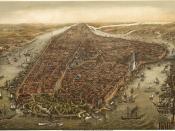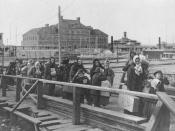Upon arrival in a foreign country, the need to assimilate is crucial. Many immigrants to America in the 1920s and 1930s felt the pressure to fit in. One group of Americans who struggled the most during these times was the Jewish community. Through their work, artists expressed their confusion, comical misinterpretations, and surrender as they were forced to assimilate into everyday culture. In the following works by Peter Blume, Dan Weiner, and Morris Shulman, even the outsider can feel the toil that the artists must have felt.
For some, the required assimilation was perplexing. Peter Blume articulated this feeling in his piece "Pig's Feet and Vinegar," which was painted in 1927. At this time, he was attempting to blend in to American culture, and he was confused with himself and the path that he was taking. This is apparent through the unfinished objects in the picture, such as the trees that disappear between the window panes.
Also, the houses look as if they had just been constructed within a short period of time, without much care as to how it looks. This could represent how he is confused with himself and to why he must hide his religion. In order to survive, he must frantically hide a part of himself, but he questions why this must be done, and whether or not it is right. Another sign of his uncertainty can be seen through the fuzzy outline of the objects in the picture. Except, perhaps, for the window panes, nothing is sharply drawn in this painting. There is a slight softness around each object, signifying the message's cryptic feeling. Blume stifles himself by hiding inside, where the sacrilegious pig's feet and vinegar are, and only looking outside to what he used to be, by the soft white wintry...



Good
I thought you wrote decently well.. I'd give it a 95% but not A+... your transitions were shaky in some parts but excellent overall.
0 out of 0 people found this comment useful.